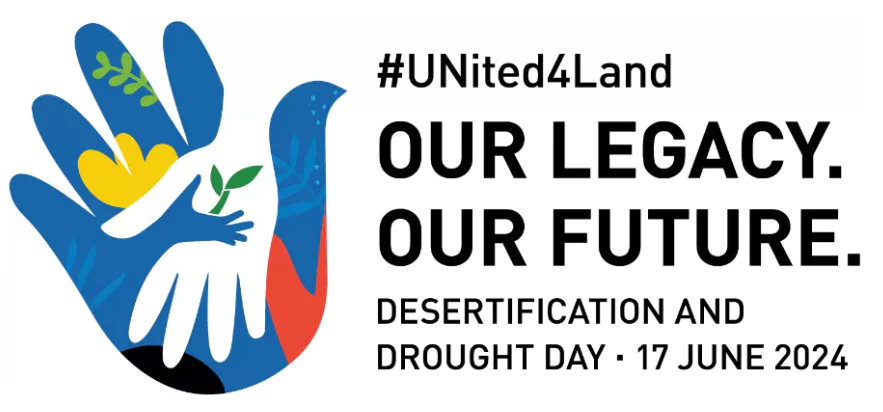17th June 2024 marks 30 years of the adoption of the United Nations Convention to Combat Desertification (UNCCD), now observed as the World Day to Combat Desertification and Drought.
World Day to Combat Desertification and Drought 2024

- Adoption: The United Nations Convention to Combat Desertification (UNCCD) was adopted on June 17, 1994, in Paris.
- 2024 will mark the 30th anniversary to the adoption of the convention
The Event of 2024
The Event will be held in the UNCCD Secretariat at Bonn, Germany
- The UN call: The United Nations urged support from all generations for sustainable land stewardship ahead of the 16th Conference of Parties (COP16) to the UNCCD in Riyadh, Saudi Arabia.
- Theme: “United for Land: Our Legacy. Our Future”
- Land Heroes: The Bonn event felicitated 10 youngsters as ‘Land Heroes’ who have worked to restore land, boost resilience to drought, develop sustainable agricultural businesses, and harness technology and innovation to tackle global environmental challenges worldwide.
Enroll now for UPSC Online Course
Land degradation
- Definition: As per the UNCCD, ‘Land Degradation means reduction or loss, in arid, semi-arid and dry sub humid areas, of the biological or economic productivity and complexity of rainfed cropland, irrigated cropland or range, pasture, forest and woodlands resulting from land uses or arising from human activities and habitation patterns”.
- Components of Land Degradation:
- Soil degradation: Decline in the productive capacity of the soil as a result of soil erosion and changes in the hydrological, biological, chemical and physical properties of the soil.
- Vegetation degradation: Decline in the quantity and/or quality of the natural biomass and decrease in the vegetative ground cover.
- Water degradation: Decline in the quantity and/or quality of both surface and ground water resources.
- Climate deterioration: Changes in the micro- and macro-climatic conditions that increase the risk of crop failure.
- Losses to urban/industrial development: Decline in the total area of land used, or with potential, for agricultural production as a result of arable land being converted to urban, industrial and infrastructure uses.
- Need to halt Land Degradation:
- Extent of Land Degradation: Up to 40 per cent of the world’s land and nearly half the world’s population are affected by land degradation, losing the equivalent of four football fields to land degradation every second (a total of 100 million hectares every year)
- Affected Communities: Land Degradation and its negative impacts are borne mostly by the marginalised communities like the indigenous communities, rural households, smallholder farmers, and especially youth and women.
- Around a quarter of the world’s population is affected by drought.
- Dependency: Over 1 billion young people living in developing countries depend on land and natural resources and by 2050, the number will increase to 10 billion people
- Economic and sustainability opportunities: Engaging the youth to restore land could create an estimated 600 million jobs needed in the next 15 years which will in turn, contribute to both economic growth and environmental sustainability.
- Land Degradation in India:
- The extent of land degradation and desertification in the country has been estimated to be 97.84 million hectares in 2018-19 as per the Desertification and Land Degradation Atlas of India, published by Space Applications Centre (SAC) Indian Space Research Organisation, Ahmedabad.
- Government Measures:
- Observation: An online portal has been developed with the help of Space Application Center(SAC), Ahmedabad for visualization of degraded area of land with the processes causing degradation.
- South – South collaboration: A Centre of Excellence has been envisaged at the Indian Council for Forestry Research and Education (ICFRE) Dehradun for enhanced South-South Cooperation. It aims at knowledge sharing, promotion of best practices, sharing of India’s experiences with cost-effective and sustainable land management strategies, developing ideas for transformative projects and programs and capacity building.
- Bonn Challenge: At the UNFCCC COP, 2015 in Paris, India joined the voluntary Bonn Challenge and pledged to restore 13 million hectares (mha) of degraded and deforested land by the year 2020, and an additional 8 mha by 2030.
- This pledge to restore 21 m.ha by 2030 has been increased to 26 mha, during the COP14 to the United Nations Convention to Combat Desertification (UNCCD) in 2019.
- Rehabilitation of Coastal habitat: The Rehabilitation of Coastal habitat through the formation of bio shield is being implemented for three years (2023-24 to 2025-26) by the state of Tamil Nadu in all its coastal districts.
Check Out UPSC NCERT Textbooks From PW Store
The United Nations Convention to Combat Desertification (UNCCD)
- About: It is the only legally binding framework set up to address desertification and the effects of drought.
- It is a multilateral commitment to mitigate the impact of land degradation, and protect our land so we can provide food, water, shelter and economic opportunity to all people.
- Members: There are 197 Parties to the Convention, including 196 country Parties and the European Union.
- Secretariat: The UNCCD permanent secretariat is located in Bonn, Germany.
- Principle: The Convention is based on the principles of participation, partnership and decentralization
- Areas of Focus: The Convention addresses specifically the arid, semi-arid, and dry sub-humid ecosystems known as the drylands.
- Conferences of the Parties (COPs): A Conference of the Parties (COPs) is held every two years of the parties to the convention.
- Financial Mechanism: The Global Mechanism (GM) established in 1994 under Article 21 of the Convention facilitates the mobilization of financial resources to implement the Convention and address desertification, land degradation and drought.
- The UNCCD 2018-2030 Strategic Framework: It is a global commitment to achieve Land Degradation Neutrality (LDN).
- Aim: It aims to restore the productivity of vast expanses of degraded land, improve the livelihoods of more than 1.3 billion people, and reduce the impacts of drought on vulnerable populations.
|
![]() 18 Jun 2024
18 Jun 2024

